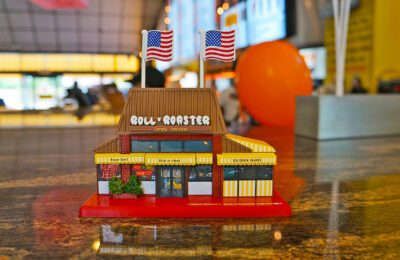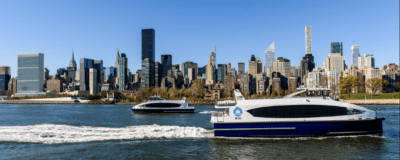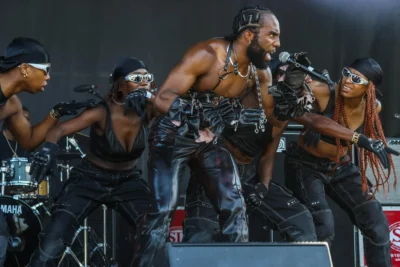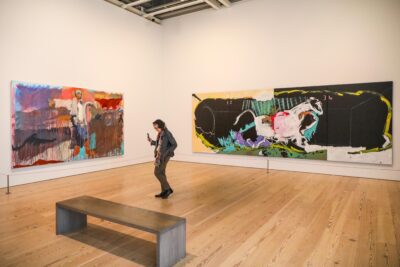All photos by Scott Lynch
Inside Brooklyn’s last lesbian bar
Ginger’s Bar in Park Slope has reopened after months of uncertainty, providing a safe space for a community that’s running out of them
It’s a rainy Sunday evening at Brooklyn’s only lesbian bar and two local women are kicking off a round of pool. While one lines up a shot, her companion reminisces over time spent in the bar over the years. “It’s a very welcoming space,” she says. “I used to love ‘The L Word’ watch parties on Sundays—it always got crazy.”
Located on Park Slope’s Fifth Avenue, Ginger’s Bar, owned by Sheila Frayne, is a local institution. With more than 20 years of business under its belt, it is a reflection of Brooklyn’s vibrant queer history with an Irish twist, and more specifically, the lesbian roots of the neighborhood once known as “Dyke Slope.”
Below a bright orange—you could call it ginger—ceiling, there’s something for everyone: the athlete (a shelf of sports trophies), the activist (protest posters), the artist (queer masterpieces), the elder (historical queer memorabilia). Two large flags, pride and Irish, preside over the main room. And in the back lives the ancient pool table, plus a brand-new mobile stage.
The restrooms are themselves museums of queer culture, their walls plastered with iconic imagery: magazine photos of Jane Lynch and the original cast of “The L Word,” newspaper clippings from Pride marches of decades past, and more. Need an excuse to wash your hand for the CDC-recommended 20 seconds? Gaze upon the display of vintage pin-up style photos just above the sinks.
The menu is dynamic and unpretentious, matching Ginger’s laid back, old school vibe. Featured beverages include beers from a rotation of micro-breweries, many of them female-owned and Brooklyn-based. Enjoy a Dyke beer in a cozy window seat with your date, sip a spiked hot apple cider with friends around the digital jukebox, or enjoy an evening in the light-strung backyard (seasonally equipped with electric heaters) with Ginger’s’ hot toddy spinoff, featuring black tea, amaro, and rum. And for sober folks, there are plenty of nonalcoholic options. Soon, you can order from a new cocktail (and mocktail) menu, and there will also be a selection of Irish snacks, such as imported chocolates and “crisps.” “Everything is affordable,” points out Frayne’s business partner Brendan Donohoe.
To its loyal patrons, Ginger’s is more than a bar. “It’s one of the few spaces where I’ve felt that I can exercise queer friendship,” Erica Rose, founder of “The Lesbian Bar Project” campaign to support the endangered lesbian bar scene, told Lilith Magazine earlier this month. “It’s a place where my friends and I could be our authentic selves.”
This authenticity is still all here. As is diversity and deeply planted queer roots—in the 1990’s, the space was home to a gay men’s bar named for the notorious prohibitionist, Carrie Nation. “It’s still a dive bar and we never want that to change,” says Donohoe. “When people walk in, we want them to know that the physical bar itself has been here for 125 years.”
But there was a moment when it all could have gone away.
The disappearing dyke bar
Normally, Ginger’s is a go-to hub for Brooklyn’s nearest and queerest, but in the spring of 2020, just before its 20th anniversary celebration, Frayne reluctantly shuttered the bar’s storefront in response to the Covid pandemic. “We didn’t sell food so I didn’t see any point in trying to keep it going,” she says. “None of us knew the right thing to do in the circumstances.” For 19 months Ginger’s laid dormant, leaving Park Slope residents—and the entire New York City queer community—wondering if we’d lost another local business to the financial fallout of the pandemic.
The thing is, Ginger’s is not just “another local business.” It is one of only three lesbian bars in the entire city (four, if you count the Dave’s Lesbian Bar pop-up events in Queens). Nationwide, there are only 21.
Until the early 1990s, Brooklyn was bursting with lesbian bars and other queer spaces, many of which are archived in local artist, activist, and educator Gwen Shockey’s Addresses Project. Businesses such as Cattyshack and La Papaya reveal a rich history, not only of queer folks creating community, but also reclaiming space—and not just from the confines of heteronormativity, but also from the literal mob: For several decades, the Italian mafia ran most of the city’s gay and lesbian bars. While this meant that the bars and patrons were safe from police raids, according to Shockey, it also meant that queer folks were not in control of their own spaces.
One may wonder if preserving lesbian bars still matters—it’s not like queer New Yorkers have to hide in the shadows anymore. But where else can you belt out an off-key rendition of Tegan and Sara’s “Closer” with 50 strangers who share an understanding of the intricacies of queer culture? Sure, there is still a handful of other local queer-women-centered spaces—the Lesbian Herstory Archive in Windsor Terrace and KIT (formerly known as Meme’s Diner) in Prospect Heights, to name a couple. But much of the gay rights movement began in bars and at house parties (think: Stonewall). And bars are where queer folks frequently found safety and community throughout the 20th century. Many still do.
From mob ties to safe spaces
So why are the dyke bars disappearing? “The sale of alcohol makes money,” Shockey notes, but it’s often not enough. Consider former Mayor Rudolph Giuliani’s enforcement of the Prohibition-era Cabaret Law in the early 2000’s—the crack-down on activities such as dancing and playing loud music in bars without proper licensing certainly took a toll on these businesses, especially considering that their clientele (women) statistically have less expendable income than men, not to mention the internet’s role in decreasing demand for physical community space. And when people do go out, they want to do more than drink—they want to eat, dance, share art, and make music.
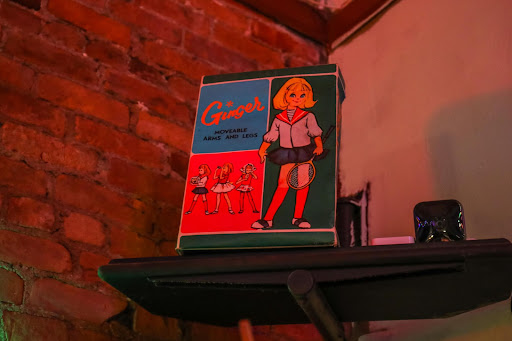
Scott Lynch
To complicate matters further is the dilemma of assimilation. With a growing social acceptance of queerness, there’s less of a need for queer spaces, points out artist Macon Reed in “Eulogy for a Dyke Bar,” an interactive, community-centered space. It’s great that many of us can be out and proud, but it’s to the detriment of queer bars, as well as to the opportunity to enjoy queer community and culture (imagine asking a DJ at Union Hall to play Robyn’s queer anthem “Dancing on My Own,” or showing up to Commonwealth in full drag—it’s just not the same). And many queer folks, particularly trans women of color, still face discrimination in hetero spaces (and even some lesbian bars); safety is not yet a guarantee.
In terms of queer identity, Rose encourages us to “expand our confines of what it means to be a lesbian [so] we can start to look at the future and the fluidity of that term.” Plus, plenty of folks who identified as lesbians in the 20th century may not identify as such today, given our expanding and expansive assortment of queer identities. Around the Ginger’s pool table you’re likely to meet pansexuals from Park Slope, lesbians from Lefferts, bisexuals from Boerum Hill, and nonbinary New Yorkers of all sexual identities. According to Shockey, the goal of any lesbian bar is to “preserve spaces where people feel safe and seen.” Continuing to use the term “lesbian bar” is not an attempt to gatekeep on the basis of sexual or gender identity, but rather to honor the history of these spaces–and this label perhaps advises straight cis men, Hey, this isn’t for you.
“I’m bi and I feel so much safer in a lesbian bar because I’m not worried about straight men harassing me or hitting on me,” one patron tells Brooklyn Magazine. “It feels like a safe space in the most literal sense of the word.”
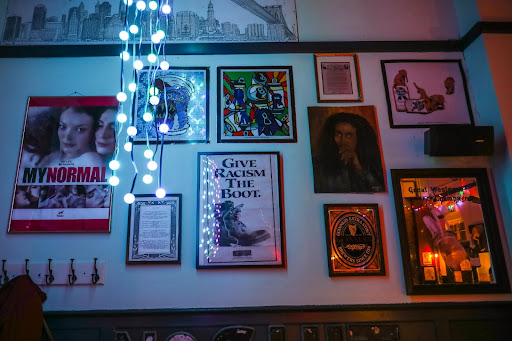

Scott Lynch
To help generate inclusiveness of all kinds (and business, of course), Ginger’s management and staff are planning a new lineup of events for a wide range of identities and interests. In December and February, they hosted queer craft markets of local artisans and their wares, complete with rainbow jewelry, linocut prints, seasonal baked goods, and more than a few artistic vagina renderings. This winter has also featured the first ever Ginger’s poetry reading, as well as pool competitions, karaoke nights, a clothing swap, and drag king showcases. And this is only the beginning. Donohoe is teasing the possibility of converting Ginger’s into a cafe/work space during the daytime come spring. Event announcements can be found on Ginger’s’ Instagram. “Watch this space,” Donohoe says.
According to Donohoe, these events are “an informed approach that includes the team…It’s important that there’s representation from the people who work here. It’s a clear indication of those who feel welcome to come here.” At a time when younger generations are “bashing gender to pieces,” according to Shockey—and as the only lesbian bar in a borough that is 64 percent nonwhite—Ginger’s aims to reflect the diversity of the Brooklyn queer population, despite its location in a predominantly white and wealthy neighborhood.
It takes a village
For months, the reopening of Ginger’s was anything but guaranteed. “My landlord was very kind—he didn’t make me pay back any of the rent when I was closed,” says Frayne. A friend helped her create a GoFundMe, which raised over $24,000. Frayne used the proceeds to pay additional bills and gave as much as possible to the staff. “I was very touched by it all,” she says. With the help of the financial relief and her new business partner, Frayne was able to secure a future for Ginger’s.
By the time Ginger’s reopened, the garden had become overgrown with weeds, the interior needed refreshing, and some new staff was needed. But in mid-January, the bar kicked off a new series of monthly poetry nights, signaling to its (vaccinated) Doc Martens-clad masses that Ginger’s was back. The Omicron surge threw the Ginger’s another curveball, but according to Donohoe, “We’ve made it a point to be quite particular about how we entertain Covid in the space.” They check all vax cards and enforce additional precautions for events on a circumstantial basis.
In just a few weeks Ginger’s will celebrate its 23rd anniversary, and Frayne is optimistic. “We were here when 9/11 happened, we were here when Sandy happened, we were here when Obama got elected, we’ve been here for many good things and bad things,” she says. “We’re not planning on going anywhere anytime soon.”
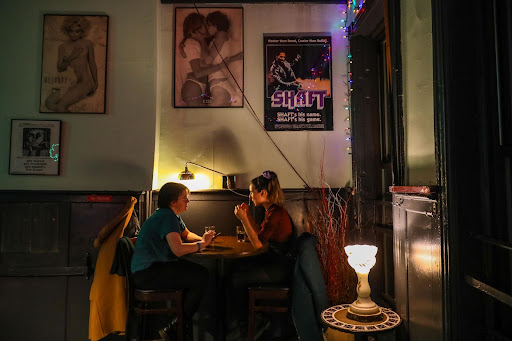

Scott Lynch
This article first appeared in the winter/spring 2022 issue of Brooklyn Magazine. Click here to subscribe today.
You might also like 


















